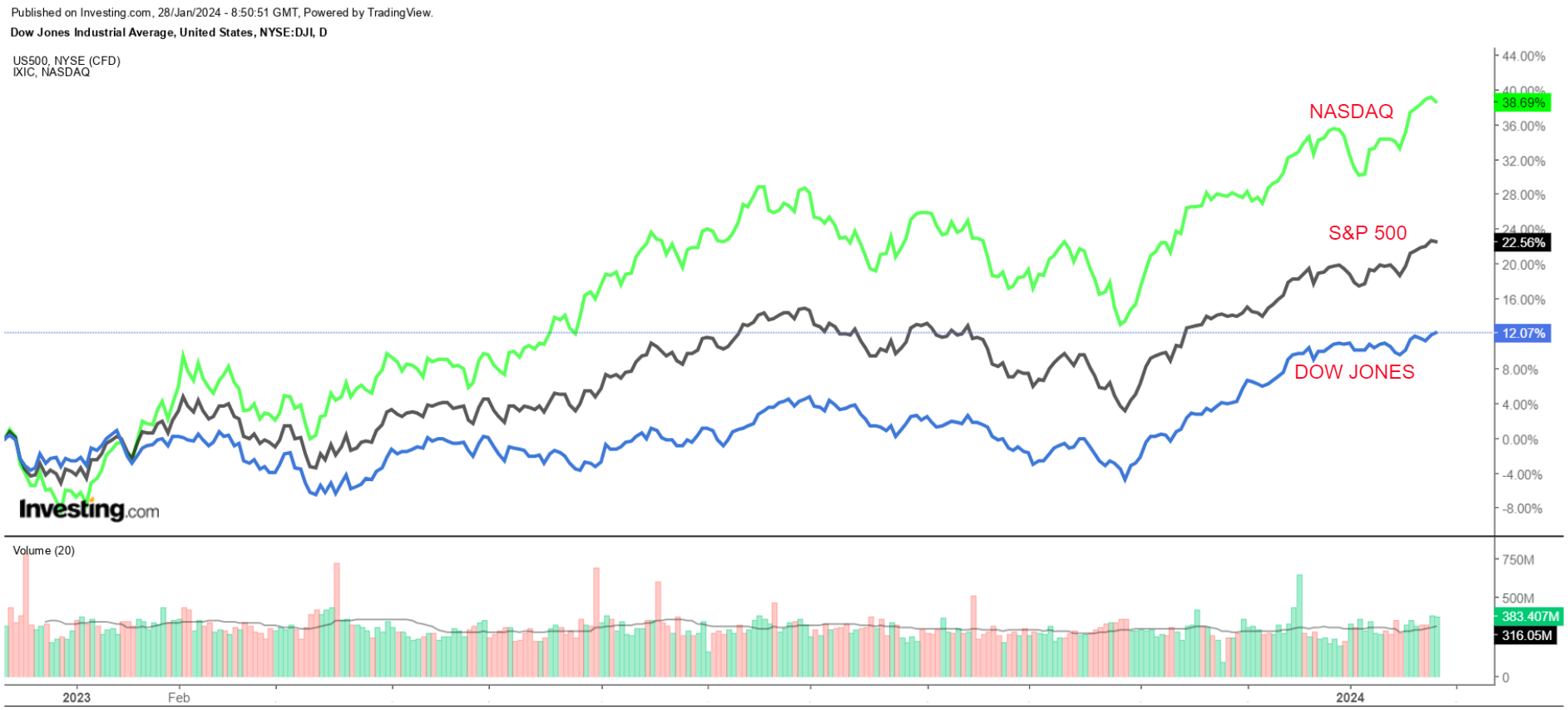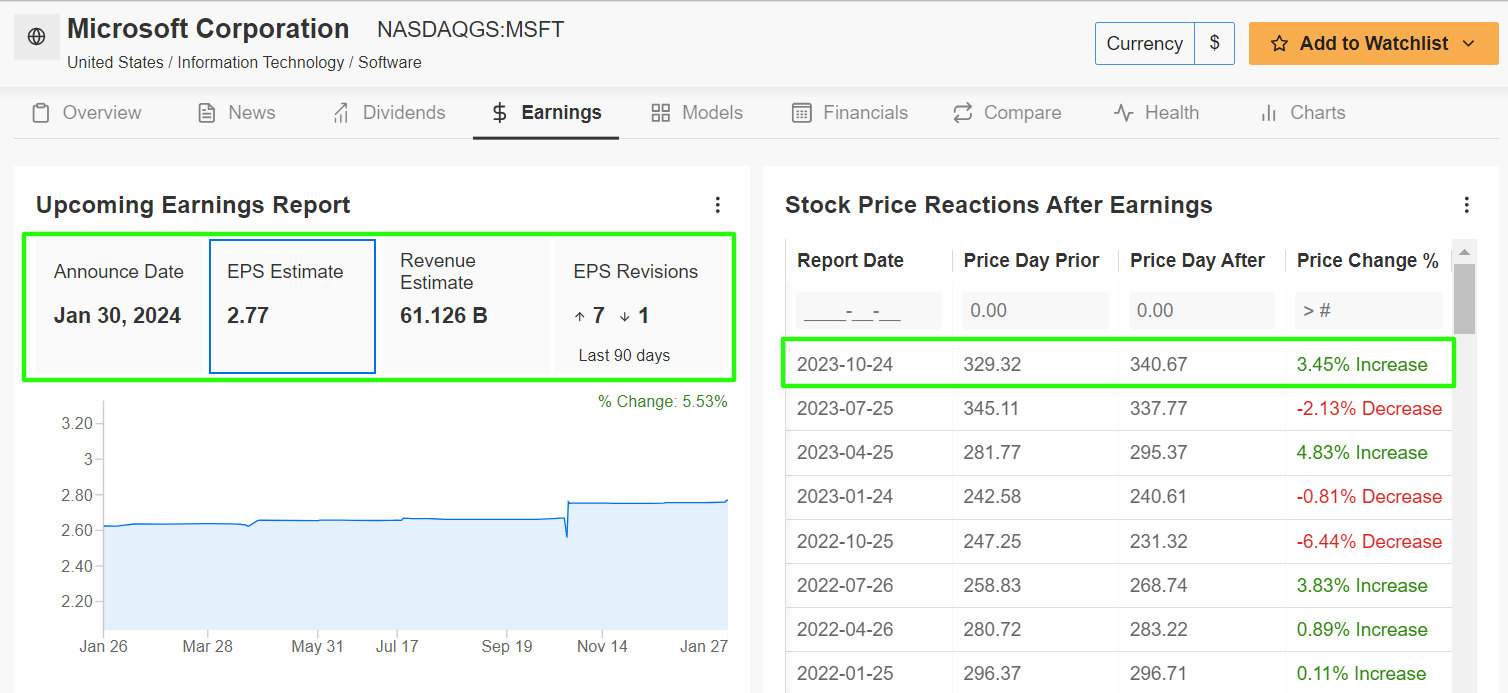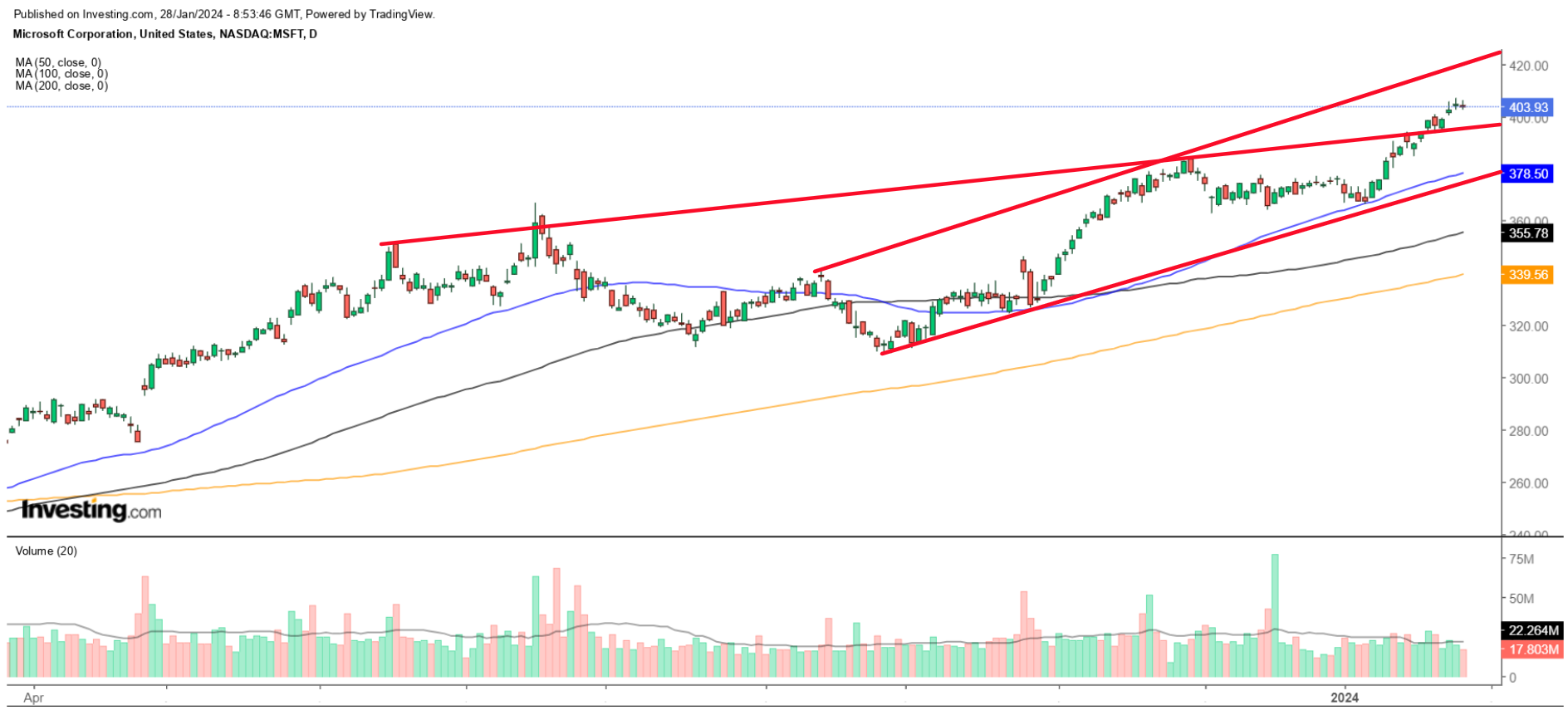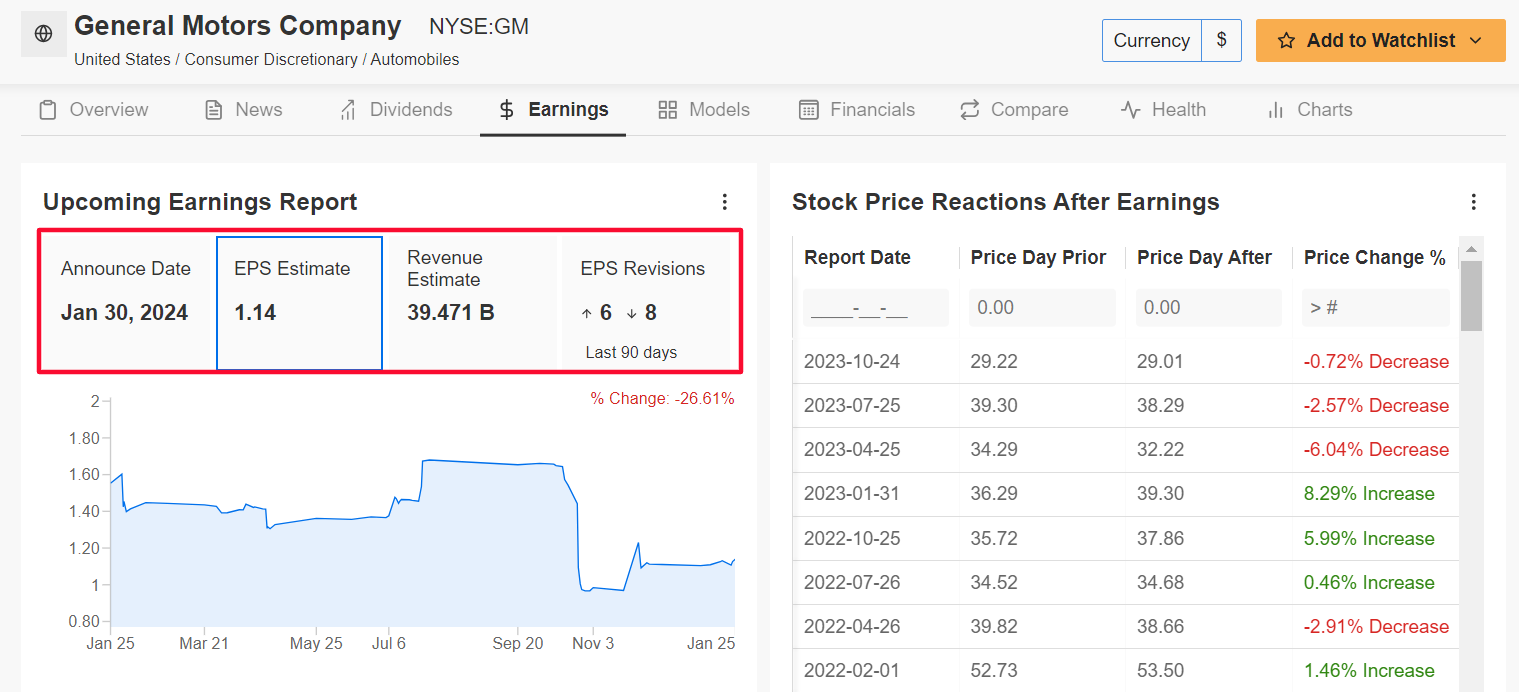- Fed meeting, January jobs report, and heavyweight tech earnings will be in focus this week.
- Microsoft (NASDAQ:MSFT) is a buy with a strong beat-and-raise quarter expected.
- General Motors (NYSE:GM) is a sell amid weak profit, disappointing guidance on deck.
- Looking for more actionable trade ideas to navigate the current market volatility? Members of InvestingPro get exclusive ideas and guidance to navigate any climate. Learn More »
U.S. stocks closed slightly lower on Friday as investors digested the latest batch of earnings and continued to assess the Federal Reserve’s rate plans for the months ahead.
Despite Friday’s downbeat performance, all three major averages posted weekly gains. The blue-chip Dow Jones Industrial Average added 0.7%, the benchmark S&P 500 inched up 1.1%, and the tech-heavy Nasdaq Composite advanced 0.9%.
The blockbuster week ahead is expected to be an eventful one filled with several market-moving events, including a key Fed monetary policy meeting, as well as a closely watched employment report and a flurry of heavyweight tech earnings.
The U.S. central bank is widely expected to leave interest rates unchanged on Wednesday, but Fed Chair Jerome Powell could offer hints about when rate cuts might start when he speaks in the post-meeting press conference.

Investors have largely pushed back expectations for the Fed’s first cut from March to May following a recent batch of strong economic data, as per the Investing.com Fed Rate Monitor Tool.
Besides the Fed, most important on the economic calendar will be Friday’s U.S. employment report for January, which is forecast to show the economy added 177,000 positions, compared to jobs growth of 216,000 in December. The unemployment rate is seen holding steady at 3.7%.
Meanwhile, the earnings season hits full swing, with five of the massive ‘Magnificent Seven’ tech stocks set to report their latest results. Microsoft, and Google-parent Alphabet (NASDAQ:GOOGL) report on Tuesday night, while Apple (NASDAQ:AAPL), Amazon (NASDAQ:AMZN), and Meta Platforms (NASDAQ:META) are due late Thursday.
These mega-caps will be joined by big names like Advanced Micro Devices (NASDAQ:AMD), Qualcomm (NASDAQ:QCOM), Boeing (NYSE:BA), United Parcel Service (NYSE:UPS), General Motors, ExxonMobil (NYSE:XOM), Chevron (NYSE:CVX), Mastercard (NYSE:MA), Starbucks (NASDAQ:SBUX), Pfizer (NYSE:PFE), and Novo Nordisk (NYSE:NVO).
Regardless of which direction the market goes, below I highlight one stock likely to be in demand and another which could see fresh downside. Remember though, my timeframe is just for the week ahead, Monday, January 29 - Friday, February 2.
Stock To Buy: Microsoft
I expect Microsoft to extend its march higher in the week ahead, with a possible breakout to a new record on the horizon, as the software-and-hardware giant gets set to deliver another quarter of double-digit profit and revenue growth.
The Redmond, Washington-based company is scheduled to release its fiscal second quarter update after the U.S. market closes on Tuesday at 4:05PM ET, and it is expected to shatter its sales record once again as growth prospects in cloud computing and artificial intelligence remain strong. A call with CEO Satya Nadella is set for 5:30PM ET.
Market participants expect a sizable swing in MSFT shares following the print, as per the options market, with a possible implied move of around 5% in either direction. Shares rose about 3.5% after the company’s last earnings report in October.
As could be expected, an InvestingPro survey of analyst earnings revisions points to mounting optimism ahead of the print amid broad strength in its cloud business and AI initiatives. The last seven EPS revisions from analysts have all been to the upside, while 51 out 56 analysts covering MSFT have a Buy-equivalent rating on the stock.
As seen above, Microsoft is forecast to earn $2.77 a share in fiscal Q2, surging 19.4% from EPS of $2.32 in the year-ago period, amid the positive impact of reduced operating expenses and ongoing job cuts. Meanwhile, revenue is expected to grow 16% annually to a record $61.1 billion.
As always, most of the focus will be on the performance of Microsoft’s Intelligent Cloud division, which includes Azure cloud services, Windows Server, SQL Server, Visual Studio, Nuance, GitHub, and Enterprise Services. The key unit is forecast to see sales growth of 17.5% to $25.3 billion.
But as is usually the case, it is more about guidance than results. Taking that into account, I reckon Microsoft will provide an upbeat outlook for the months ahead as it continues to benefit from its leading position in the AI space.
MSFT stock ended Friday’s session at $403.93, a tad below its all-time high of $407 from the previous session. With a market cap of $3 trillion, Microsoft is the most valuable company trading on the U.S. stock market, overtaking Apple.
Shares are up 7.4% so far in 2024 after scoring an annual gain of 56.8% in 2023 as the tech titan benefits from its growing involvement in the emerging AI field.
As ProTips points out, Microsoft is in great financial health condition, thanks to solid earnings prospects, and a robust profitability outlook. Additionally, it should be noted that the company has raised its dividend for 18 years running.
Stock to Sell: General Motors
I foresee a weak performance for General Motors stock in the coming week, as the legacy automaker’s latest earnings report will probably underwhelm investors due to the negative impact of various headwinds on its business.
GM’s update for the fourth quarter is scheduled to come out before the opening bell on Tuesday at 6:30AM ET and results are likely to take a hit from slowing consumer demand for its wide array of vehicles amid elevated interest rates and a deteriorating electric vehicle market.
Underscoring several near-term headwinds facing GM amid the current climate, eight out of 14 analysts surveyed by InvestingPro lowered their EPS estimates in the three months leading up to the print to reflect a drop of 26.6% from their initial profit forecasts.
As per the options market, traders are pricing in a move of about 5% in either direction for GM stock following the release. Notably, shares suffered their third straight negative earnings-day reaction after the company’s Q3 report in October. 
Wall Street sees the Detroit, Michigan-based automaker earning $1.14 a share in the final three months of 2023, tumbling -46.2% from a profit of $2.12 in the year-ago period, amid rising operating and labor costs.
Revenue is expected to drop -8.4% year-over-year to $39.5 billion, as higher interest rates and a weaker economic backdrop discourage consumers from making big-ticket purchases.
As such, it is my belief that CEO Mary Barra and GM executives will disappoint investors in their forward guidance for the first quarter of 2024 and strike a cautious tone amid the uncertain macroeconomic environment.
GM stock closed at $35.18 on Friday, earning the auto manufacturer a valuation of $48.2 billion. Shares have gotten off to a downbeat start to the new year, falling 2% thus far in January after ending 2023 with a gain of 6.8%.
It is worth mentioning that General Motors stock appears to be a tad overvalued, according to the quantitative models in InvestingPro. Its ‘Fair Value’ price estimate stands at $33.46, which points to a potential downside of -4.9% from the current market value.
Be sure to check out InvestingPro to stay in sync with the market trend and what it means for your trading. As with any investment, it's crucial to research extensively before making any decisions.
InvestingPro empowers investors to make informed decisions by providing a comprehensive analysis of undervalued stocks with the potential for significant upside in the market.
Disclosure: At the time of writing, I am long on the S&P 500, and the Nasdaq 100 via the SPDR S&P 500 ETF (SPY), and the Invesco QQQ Trust ETF (QQQ). I am also long on the Technology Select Sector SPDR ETF (NYSE:XLK).
I regularly rebalance my portfolio of individual stocks and ETFs based on ongoing risk assessment of both the macroeconomic environment and companies' financials.
The views discussed in this article are solely the opinion of the author and should not be taken as investment advice.
